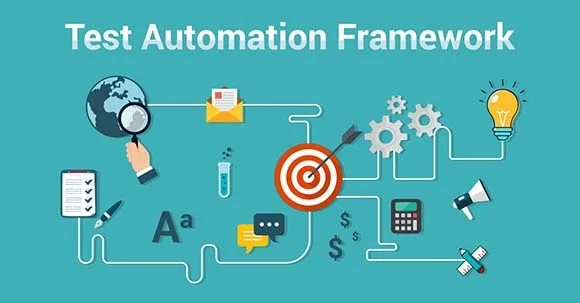
Test automation has become increasingly important in the software development life cycle due to the need to ensure high-quality products while mitigating time and cost constraints. With the array of test automation frameworks available, selecting the best approach can be overwhelming.
However, choosing an appropriate framework for automation testing that is coherent with the application architecture, testing objectives, and overall project strategy is crucial. During the design phase, one needs to deliberate thoughtfully on various critical elements to ensure the effectiveness of a test automation framework.
This blog will discuss the seven essential components of a test automation framework that can help organizations develop and deploy high-quality software applications with speed and agility.
Let’s go.
What is an Automation Testing Framework?
Automation testing frameworks are defined as the set of standards or notions for effectively structuring and writing test cases. It has various tools and components that help testers perform the test more efficiently and quickly. The included standards may be coding guidelines, techniques for processing test data, object repositories process for having test outcomes, and others.
However, it is worth noting that testers can write and record tests without adhering to the above standards. Still, using an automation testing framework is beneficial because it gives more advantage in improving software application quality. It does not matter which automation testing framework you are using; it is always advisable to execute test on a real device cloud to maintain the accuracy of the test in a real-world environment.
To this, digital experience testing platform like LambdaTest allows web and mobile application testing with a wide range of test automation frameworks. It allows cross browsers testing and gives access to the large farm of 3000+ browsers, devices, and OS to run the test.
7 Essential Components Of A Test Automation Framework
Test automation frameworks have become a critical component of the testing process, providing organizations with valuable time and resource savings and enhancing overall testing efficiency. Creating a high-performing test automation framework requires a profound comprehension of the software development lifecycle, testing principles, and current industry best practices.
Here are the seven essential components of a test automation framework:
Test Environment Setup
The test environment setup is a critical component of any test automation framework. It is imperative to have a properly configured environment to test and validate the application’s functionality accurately. Thus, allocating sufficient time and resources is essential to establish the test environment correctly. This includes proficiently installing and configuring the necessary software and hardware components with the utmost focus on the stability and security of the environment.
The test setup must incorporate suitable version control and defect-tracking mechanisms to ensure the efficient recording and management of test results and defects. A well-configured test environment not only improves the overall quality of the test suite but also performs a critical function in the success of test automation endeavors.
Test Data Setup
The second essential component of a test automation framework is test data setup. This component is crucial in ensuring the tests are performed in a controlled environment with consistent data. Test data setup includes creating, modifying, and deleting data required for testing. Automating test data setups saves valuable time and eliminates inconsistencies and errors.
The test data setup should exhibit flexibility to allow for the easy creation or modification of data to suit various test scenarios. Proper clean-up of test data after each test execution is crucial to prevent data pollution and avoid any potential negative impacts on subsequent tests. Additionally, this component must adhere to privacy regulations and data security policies to ensure sensitive data is handled and stored appropriately.
Furthermore, the test data setup must complement other framework components, including test case management and reporting, to facilitate a comprehensive understanding of the testing process. The successful integration of test data setup guarantees efficient and dependable test automation, which expedites the overall testing process.
Automation Test Scripts
An integral aspect of a proficient test automation framework is the implementation of Test scripts. These automated sequences of instructions verify that the application is functioning as intended by simulating user interactions with the application being tested. Test scripts can be developed using programming languages such as Java, Python, Ruby, and others to facilitate the swift and precise execution of repetitive testing procedures, thereby enhancing the efficiency and speed of the overall testing process.
Test scripts provide comprehensive feedback on the application’s performance, functionality, and usability. Incorporating test scripts into your test automation framework is imperative, as they are pivotal in augmenting your testing methodology’s precision, effectiveness, and efficiency. By integrating test scripts into your testing regimen, you can deliver software releases of superior quality.
Object Repository
The object repository is a crucial component of any practical test automation framework. It is a centralized location that stores all the objects or elements in the tested application. This includes buttons, text boxes, dropdown menus, and more. By keeping all object references in a single location, the object repository allows test scripts to be written more efficiently and effectively.
The object repository provides testers with a convenient means of locating the objects required for a particular test case, eliminating the need to search the entire application. Moreover, you can effortlessly reflect any alterations made to the application’s user interface in the object repository instead of modifying each test script separately. The object repository represents a valuable asset in streamlining the testing process, safeguarding that the test scripts remain sustainable and adaptable over time.
Test Results Analysis
The fifth indispensable element of a test automation framework is test results analysis. This component centers on scrutinizing the test results, identifying the fundamental cause of any anomalies or discrepancies, and extracting meaningful insights from the accumulated data. Test results analysis holds paramount importance in verifying the efficacy and efficiency of the test cases. The analysis is a continuous and iterative process that begins with capturing the outcomes of the test execution and culminates in interpreting the final results.
During the test results analysis process, metrics such as test case pass/fail rate, test coverage, and defect density are tracked and analyzed. The insights gathered from the analysis can be used to optimize the testing process and identify areas that require improvement. Efficient test results analysis is crucial in identifying and addressing pressing issues before they impact system functionality and user satisfaction.
Error Handling
Effective “Error Handling” is a vital aspect of a well-functioning test automation framework. It refers to identifying, reporting, and resolving errors that occur during the execution of automated tests. Inadequate error handling can cause significant problems down the line. This may include inaccurate or incomplete test results, delays in identifying defects, and decreased overall testing efficiency.
An effective error-handling process comprises accurate logging and reporting of errors, exception handling, and prompt resolution of unexpected errors. Including error handling in the testing phase guarantees the proper functioning of the underlying system and aids in establishing a dependable automation framework.
Reporting Mechanism
The reporting mechanism is an essential component of a test automation framework as it helps testers and stakeholders track and analyze the test results. The objective of this component is to furnish a thorough and clear-cut report that showcases the effectiveness of the tests conducted and the problems unearthed during the evaluation procedure. The report intends to aid in comprehending the results obtained by being user-friendly.
The reporting mechanism facilitates testers in monitoring the execution process, identifying and addressing any potential issues, and producing comprehensive reports to simplify the analysis of the outcomes. The significance of defect analysis is rooted in its ability to identify and prioritize software defects, providing critical information for informed decision-making regarding software quality.
Hence, it is imperative to guarantee that the reporting mechanism is tailored to meet the project’s specific needs and provides stakeholders with the required information to facilitate well-informed decisions about the software product.
Bonus Tip: Execution Scheduling
One additional aspect that should be included among the seven critical components of a test automation framework is execution scheduling. Test automation execution scheduling facilitates the ability to plan and schedule automated tests, automatically kick off test runs, and control the execution of test scenarios. It is particularly crucial when dealing with many test cases as it helps to organize and manage the execution process involved.
With automation scheduling, users can define the time and frequency of test runs, the target environment, the test data to utilize, and how to handle test failures. This feature is also advantageous for development teams as it allows them to integrate testing into the continuous integration and delivery process, ensuring that all new builds undergo automatic testing. Ultimately, automated test scheduling is an essential function that saves time and streamlines the testing process.
Conclusion
A test automation framework is a structured and organized approach to software testing. It enables teams to easily develop, sustain, and carry out automated tests, ultimately minimizing the time and resources required for software testing. Establishing a Test Automation ecosystem is a significant investment in time and resources, yet ensuring a successful software testing process is crucial. The primary objective of automated software testing is to streamline the testing effort with minimal exertion.
The selection of the right automation tools, test procedures, and the team is crucial for successful automated software testing. While it may require a significant initial investment, the benefits of automated software testing will become apparent over time, resulting in a favorable ROI.
The seven essential components mentioned in this blog form the foundation of a robust test automation framework. Implementing these components will ensure smooth and efficient testing, resulting in high-quality software and satisfied customers.
